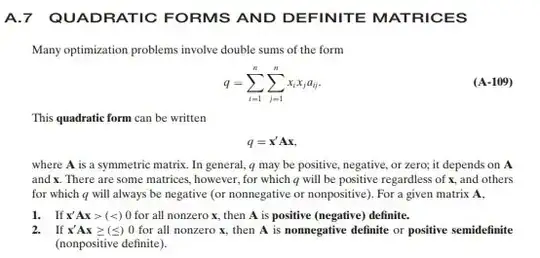The following is an excerpt from Greene's Econometric Analysis (7th Edition). Therein, the author states the matrix in quadratic forms must be symmetric. I would like to know why. What if, for instance, $a_{12} \neq a_{21}$?
-
1I agree; this may be an editorial hiccup. The intention may be that often the cases of interest in the applications can be phrased as involving a symmetric matrix. You can associate a quadratic form with any matrix. – leslie townes Feb 21 '21 at 18:10
-
2Cf. this question – J. W. Tanner Feb 21 '21 at 18:11
2 Answers
Therein, the author states the matrix in quadratic forms must be symmetric.
No, he didn't. And he didn't say the $ij$-th component in $A$ is $a_{ij}$. Here the quadratic form can be written as $x^{\top}Ax$ such that $A$ is a symmetric matrix. The representation is not unique without posing any restriction on $A$. The point is for any set of real $a_{ij}$, there always exists a symmetric $A$ such that $x^{\top}Ax=\sum_{i=1}^{n}\sum_{j=1}^{n}x_{i}x_{j}a_{ij}$, hence we can choose the matrix to be symmetric if we want.
- 1,394
$$\begin{pmatrix}x&y\end{pmatrix}\begin{pmatrix}a&b\\c&d\end{pmatrix}\begin{pmatrix}x\\y\end{pmatrix}=ax^2+(b+c)xy+dy^2$$ can be symmetrized as
$$\begin{pmatrix}x&y\end{pmatrix}\begin{pmatrix}a&\frac{b+c}2\\\frac{b+c}2&d\end{pmatrix}\begin{pmatrix}x\\y\end{pmatrix}=ax^2+2\frac{b+c}2xy+dy^2.$$
So a quadratic form has a symmetric matrix WLOG.
